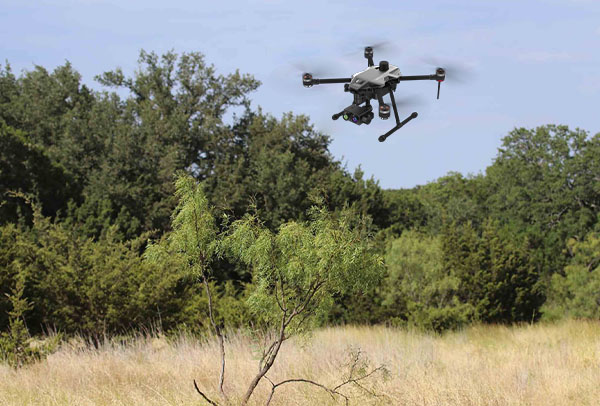The Impact of Drones on Forest Monitoring
5 minutes approx

As the world increasingly prioritizes sustainable practices, the role of technology in
environmental conservation has become more pronounced. One of the most innovative tools
making a significant impact is drones. These unmanned aerial vehicles are revolutionizing
forest monitoring and management, propelling eco-conscious initiatives to new heights.
Incorporating advanced imaging and data-gathering capabilities, drones offer unparalleled
accessibility to remote and hard-to-reach forest areas, allowing for more comprehensive and
accurate monitoring. The ability of drones to swiftly detect illegal logging activities, assess
wildlife habitats, and evaluate tree health is transforming conservation efforts.
Applications of drones in forest monitoring
Drones have swiftly cemented their status as indispensable tools in the realm of forest monitoring. Their versatility allows them to undertake a myriad of tasks, ranging from
mapping forested areas to monitoring changes in vegetation health. With their capacity to
access remote and challenging terrains, drones provide an unparalleled vantage point for
gathering critical data that was once difficult, if not impossible, to obtain. Through high-
resolution imaging and advanced sensors, drones facilitate the comprehensive surveillance of
forests, enabling conservationists to gain insights that were previously out of reach.
By harnessing the power of drones, researchers and environmental organizations can
effectively track deforestation activities, detect illegal logging operations, and monitor the
encroachment of human activities into protected forest areas. Their ability to cover large
geographical areas in a relatively short span of time empowers conservationists to obtain a
holistic understanding of the dynamics at play within forest ecosystems.
Advantages of using drones for forest monitoring
The utilization of drones for forest monitoring presents a multitude of advantages that are
reshaping the landscape of environmental conservation. Firstly, drones offer a cost-effective
alternative to traditional methods of aerial surveillance, such as manned aircraft or satellite
imaging. Their relatively low operational costs and ability to cover vast areas make them a
compelling choice for organizations seeking to maximize the impact of their conservation
endeavours within constrained budgets.
Moreover, the non-intrusive nature of drones minimizes the ecological footprint associated
with data collection activities. Unlike ground-based surveys that may disturb wildlife or
disrupt fragile ecosystems, drones can conduct monitoring operations with minimal
interference. This non-disruptive approach not only safeguards the integrity of the natural
environment but also ensures the accuracy and reliability of the data obtained.
Environmental impact assessment using drone technology
The utilization of drone technology for environmental impact assessment represents a
paradigm shift in the way we gauge the repercussions of human activities on forest
ecosystems. By leveraging the capabilities of drones to capture high-resolution imagery and
geospatial data, conservationists can conduct comprehensive evaluations of deforestation
rates, habitat fragmentation, and the overall health of forested landscapes.
Through the integration of advanced sensors and imaging technologies, drones can detect
subtle changes in vegetation cover, identify areas of degradation, and monitor the impact of
climate change on forested regions. This granular level of insight enables conservationists to
formulate targeted interventions and management strategies that are tailored to the specific
needs of forest ecosystems, thereby optimizing the allocation of resources and maximizing
the efficacy of conservation initiatives.
Furthermore, the real-time data acquisition capabilities of drones empower conservationists
to respond swiftly to emerging environmental threats, such as forest fires or illegal logging
activities. By providing timely and accurate information, drones facilitate proactive decision-
making, allowing stakeholders to implement measures that mitigate the negative impact of
such disturbances on forest ecosystems.
Implementing a sustainable drone-based forest monitoring program
The successful implementation of a sustainable drone-based forest monitoring program
hinges on a multifaceted approach that encompasses technological proficiency, regulatory
compliance, and stakeholder engagement. Firstly, organizations seeking to deploy drones for
forest monitoring must invest in training and equipping personnel with the requisite skills to
operate and maintain drone systems effectively. This involves the cultivation of expertise in
aerial data collection, image analysis, and the interpretation of geospatial information derived
from drone-generated datasets.
Additionally, adherence to regulatory frameworks governing the use of drones in
environmental monitoring is paramount to ensure ethical and lawful practices. Organizations
must navigate the complex terrain of aviation regulations, privacy considerations, and
environmental impact assessments to obtain the necessary permissions and approvals for
conducting drone-based monitoring activities within designated forest areas.
Moreover, fostering collaboration with local communities, indigenous groups, and
governmental agencies is essential for the successful integration of drone technology into
forest monitoring initiatives. By engaging with diverse stakeholders, organizations can gather
support for their conservation efforts, gain valuable insights into local ecological knowledge,
and promote the inclusive and participatory supervision of forest resources.
Conclusion: The role of drones in sustainable forest management
In conclusion, the advent of drone technology has ushered in a new era of sustainable forest
management, redefining the strategies and tools at our disposal for safeguarding the world's
invaluable forest ecosystems. The multifaceted applications of drones in forest monitoring,
coupled with their inherent advantages in cost-effectiveness, non-intrusiveness, and safety,
position them as indispensable allies in the pursuit of environmental conservation.
The integration of drone technology into environmental impact assessments not only
enhances the precision and comprehensiveness of data collection but also fosters a proactive
approach to conservation, thereby bolstering the resilience of forests in the face of evolving
environmental challenges.
By harnessing the transformative capabilities of drones, we can chart a course towards
sustainable forest management that prioritizes ecological integrity, community engagement,
and the enduring preservation of our natural heritage. In doing so, we embark on a collective
journey to cultivate eco-friendly eyes in the sky, ensuring that our forests thrive for
generations to come.
Back to all Blog